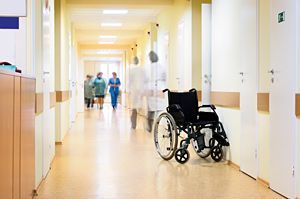Did any of you ever get the feeling in school that it simply was not OK to speak about wanting to be successful? To get into the nitty gritty details of how to make money in practice? Maybe you were even someone like me who was directly told by someone in a position of power that I needed to take what I could get because in private practice, I wouldn’t make money.
Who Does Best in a Hospital Based Practice?
It would be hard to identify any single skill that makes one successful in Hospital Based Acupuncture (HBA). In fact, I find myself increasingly frustrated as I speak with and instruct my fellow colleagues on this subject. It is not a simple matter of mastering one skill. If it were, there would be little need for any specific training. Nonetheless, certain skill-sets stand out as essentially important - if only by their absence from garden-variety private practice. Here are some tips to follow.
Don't bail out on pattern discrimination
This seems obvious, but it is nonetheless true that many practitioners emerge from school with woefully inadequate diagnostic skills and some without any real logic that could stand up to peer-review. Many practitioners - even veterans of many years - have scarcely progressed beyond the textbook understanding of discrete patterns.
Furthermore, in all my career, I have never seen a patient present with one discrete pattern. The hospital professional must know how discrete patterns interact with and affect other patterns.

One need not know hundreds and hundreds of patterns. In HBA practice - where the focus in on adjunctive treatment for common functional complaints - knowing the 30-40 most common patterns is generally sufficient; but one must know these like one's own telephone number and be able to ask pertinent questions, which identify the presence or absence of these common patterns so that diagnosis should take only a few minutes. Pattern discrimination is the gem of holism; learn it well and use it. Polish this gem and let it shine. This is bastion of HBA practice and the safe haven within which no conventional medical professional may assail you – if you know your stuff.
Pulse Examination
Pulse exam is a topic causing serious consternation for many practitioners – usually for many years. If one works in a hospital based practice, adherence to a medical system with a legitimate and large body of research is essential. This means also that one must adopt the system of pulse examination employed by the physicians in China who are conducting that research. The Nan Jing style is not suited to working within the TCM style, which is why the Chinese long-ago moved away from it to a strictly anatomical correspondence. As for the Jing Gei style touted by the community acupuncture network, its flimsy logic will not hold up to any scholarly rigor - an essential aspect of hospital based practice. The pulse should only be used to confirm or deny a diagnostic hypothesis.
Education of Different Audiences
In order to educate physicians, administrators and lay patients, the hospital based professional must have a serious command of language. This means having first clarified the linguistic parameters of holism via the statements of fact which create holistic medical reality; and then wrestling with the linguistic equivalency that will render holistic concepts intelligible to Western medical professionals.
Mitchell Lehman of San Diego, Calif. declares, "If you even say the word qi within earshot of hospital physicians, you're finished. Mention ‘yin and yang' and you're classified as a stoner and surfer who had time to kill and so decided to take up acupuncture."
How therefore should one talk to physicians about the various concepts and logical methodology, which makes up professional quality holism? How do you discuss research and present an unbiased view of the strengths and limitations of holistic methodology and Western reductionistic research? Should one speak differently to hospital administrators than to physicians? How? What do administrators care about most and how does one avoid the error of being marginalized? Better still how may one capitalize on a brief encounter with the hospital brass?
Furthermore, how does one communicate with patients in a hospital based clinic? Is it always wise to answer questions? Is there a time/situation in which it is better not to engage in dialogue with patients? When is it essential to educate and enforce the principals by which patients will receive the maximum benefit from visiting your clinic? Why is patient education so essential in the modern epoch?
These three segments - physicians, administrators and patients - are the primary audience. The hospital based clinician must be ready with well-thought-out answers and different "phraseology" for each audience segment and the specific encounters that will make or break a hospital based practice. Education is nothing if not communication; and communication has been the number one barrier to acupuncture's inclusion in mainstream medicine.1
Needle Technique
The general trend among graduates and practitioners in private practice is sloppy needle technique (meaning ambiguous or poor quality or even painful). It is clearly not a skill reinforced with much rigor by many Chinese medical schools. In addition, the comments I am told most by students I mentor are: 1) They are not shown/taught to needle with the same vigor and deliberateness as I instruct them for HBA practice; and 2) they could not get away with such vigorous needling in private practice because patients will complain it is too intense. A hospital setting requires the former and overturns the latter. A patient recovering from stroke or undergoing treatment for cancer is positively aware of the seriousness of their plight. Perhaps it is nothing more than being located within a hospital building; but I find that patients do no balk at an intense experience, but actually embrace it—the more so once they feel the positive after effects of treatment and the sense of hope that they may yet find healing in recovery.
Good needling is not brutal; but nor is it gentle and hesitant. Indeed, gentle hesitancy is often what causes unnecessary pain upon insertion. The kinesthetic sense for top quality needling may be partly wired into every clinician's general character and nervous system. I do indeed find certain acupuncturists have greater aptitude than others in this essential regard. Yet it can - to some degree - learned, taught and improved. (2) Nor is Dr. Tan's Balancing Method the panacea that so many practitioners in community acupuncture network believe it to be. It is not sufficient by itself any more than the NADA protocol is the answer to all patient complaints as professed by AWB.
Confidence and deliberateness in needling (and yes even a level of intensity that may not be welcome and appreciated in private practice) are indispensible in a hospital based acupuncture practice. Being in a hospital gives the clinician license to do what needs doing, letting patients self-select their attendance. One need not fear losing business; there are tens of thousands of patients passing through even a small hospital like Mercy Hospital and Medical here in Chicago.
Summary
To practice at the hospital level requires clinicians to know a lot of things about a lot of things. When I teach this comprehensive approach, I break it down to; 1) fundamentals; 2) fitness; and 3) performance. Fundamentals refers to the myriad basic skills and comprehension of simple details and methodological rigor that creates high-level competency. Fitness refers to practitioner self-care and attention to one's own person. Performance refers to the ability to ‘get it done.' This kind of unapologetic excellence is still rare within the holistic medical industry and is as much of an obstacle to inclusion in the mainstream as any misgivings about research or rigor of methodology.
The future of acupuncture and Chinese medicine is in Hospital settings. Those who get this will prepare accordingly.
References:
- *Survey of MDs/Administrators of Integrative Clinics to Gather Information on Competencies of Licensed Acupuncturists for Practice in Hospitals, Integrated Centers and Other Conventional Healthcare Settings Produced by the: National Education Dialogue to Advance Integrated Health Care Academic Consortium for Complementary and Alternative Health Care. For the: Integrated Healthcare Policy Consortium. Project Director: John Weeks. Key Collaborators: Pamela Snider, ND, Elizabeth Goldblatt, PhD, MPA/HA, Catherine Niemiec, JD, LAc, Kory Ward-Cook, PhD, Bryn Clark, LAc. Sponsor: National Certification Commission for Acupuncture and Oriental Medicine. December 2007
- www.bluepoppy.com/blog/blogs/blog1.php/how-to-needle-like-a-mosquito-without-su
- http://christiannix.com/pdf/a letter to lonny jarrett.pdf


